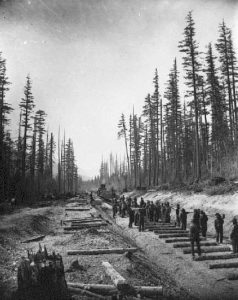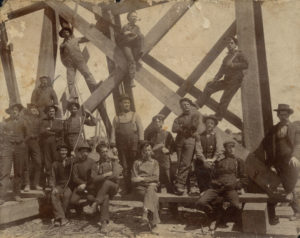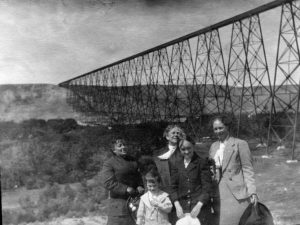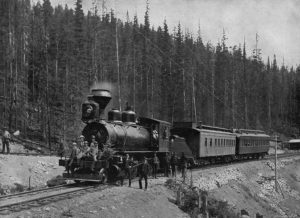Read the Following Selection
Read the following selection, or click on the play button below to listen aloud.
Canadian Pacific Railway

Canadian Pacific Railway Crew laying tracks, 1881
Canada became a new country in 1867. To unite such a huge nation, a railway had to be built that would stretch from the east coast to the west coast. The railway became known as the Canadian Pacific Railway.
Ribbon of Steel
Sir John A. Macdonald, Canada’s first prime minister, dreamed of a railway that would cross the country. He believed that this “ribbon of steel” would help hold the country together. He would see his vision realized in 1886, when the first passenger train rolled into Port Moody, British Columbia, on July 4. But getting to this point would take a lot of work and involve thousands of workers.

Work Crew posing on the Canadian Pacific Railway high level bridge
First, the survey crews headed out. It was their job to try to find the flattest and most direct route for the railway. But the line also had to be safe and as inexpensive as possible, which meant it should avoid places that would require workers to build tunnels or bridges.
Navvies
The surveying began in 1871 and was not completed until 1881. By then, the route for the railway was chosen and it was time to start laying the track. Crews began work at both the west end and the east end at the same time, to lay down the track as quickly as possible.

A family posing by the CPR High Level Bridge
The workers were called “navvies”—they got their name from the men who had built water channels known as navigation canals. These railway workers cut down trees and cleared a wide path, called the roadbed, along the line the surveyors had marked. Then they used ploughs to level the ground for the tracks.
Despite the surveyors’ best efforts, sometimes bridges had to be built for the railway. They spanned rivers and canyons and required a lot of hard, dangerous work.
Laying Down the Track
Track-laying crews came next. First, they laid wooden railway ties across the roadbed. Then, they placed a steel rail on each side of the ties. Iron spikes held the rails in place. The workers spread gravel and soil around the ties to keep them steady, then moved on to the next section.

Canadian Pacific Railway, 1895
East and West

The Canadian Pacific Railway today
Workers in the east had to blast through the Canadian Shield, which is some of the hardest rock in the world. Long pieces of track also sank and were lost in patches of muskeg, or, marsh.
The section of the railway that was built in British Columbia often wound through mountains and over rivers. It was extremely difficult to work around. Crews used dynamite to tunnel through rock and it was dangerous work that killed many workers.
Now, show what you know!
Complete some questions about the reading selection by clicking “Begin Questions” below.









